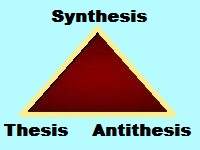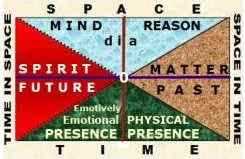
Space (Thesis) and Time (Antithesis) Merged in Absolute Terms into Spacetime (Synthesis)
VERSUS

Dialectical Creative Framework for Orientation in the Eternity of Times DIA Infinity of Spaces
In 1905 Albert Einstein (1879 – 1955) threw away the ether, and then advanced the theory of relativity that has revolutionized the understanding of space and time. As a consequence of it, twentieth century physics wrenches the mind by simply rejecting it within this physical concept of universe (Edward Harrison, 1985). In other words, there is no place in this physical understanding universe for such unmaterial things. Hermann Minkovski (1864 – 1909) showed (1908) that time and space, as a result of Albert Einstein’s theory of relativity, is actually fused together into a world of spacetime. SPACETIME is the new public domain, where people share the same spacetime, but not the same space and time. Spacetime is constructed in such a way that the distance travelled by light rays is always zero. The presented Einstein’s special theory of relativity (1905) with its speed limit of light works locally but not globally. In general theory of relativity (1916), spacetime becomes an active participant in the physical universe, where both energy and mass are affected by gravity. In other words, distant as well as local matter produce curvature and distortion of spacetime, because everything is attracted to everything else by gravity. If gravity were just a force between objects with mass, rather than the bending of space—time, then it could not be able to pull on photons, which have no mass [otherwise, photons also have some kind of mass (of the immeasurable dark energy)]. The gravity, as an attractive force, acts in effect in this model, as negative energy, causing the reaction of the curvature of spacetime. As a consequence of it, the curved space permeated and saturated with energy, and hence clothed in intangible mass, is itself a source of further curvature. SELF-INTERACTION OF SPACE is the essence of general theory of relativity (Edward Harrison, 1985).
But an unexpected consequence of the general theory of relativity is that there are circumstances, when the gravity can act as a repulsive force as well. A consequence of this new view on the time and space is that the recession velocities are infinitely great and independent of the speed of light. Or more simply said, this kind of recession does not consist of the ordinary motion through space limited by the speed of light but it occurs because of the expansion of space and time. As a consequence of this phenomenon, galaxies are separating and flying apart from one another. According to this view on spacetime, it was space itself that was expanding (inflating), as a consequence of acting of set free dark energy. It seems, to the opinion of this creator of knowledge that this energy pervades DIA further transforms itself into vacuum (dialectical synthesis DIA a renewed thesis), that came into being as a result of meeting (confrontation of) the matter and created anti-matter (within fabrics of dark holes), understood in terms of their "annihilation" (recall, in worlds of dialectics nothing disappears in absolute terms) in these INVISIBLE micro-levels of non-photonic particles of the so-called dark matter. From this reason, this kind of expansion is not constrained by the theory relativity. In this model of spacetime, the riddle of cosmic edges, was solved by the containment of time and space within the universe (Edward Harrison, 1985). About the so-called containment riddle, you can read more in the next creative article. On the other hand, to read more about Einstein's understanding of the space and time, visit the following web page: Dynamic Conceptions of Time AND Space.







